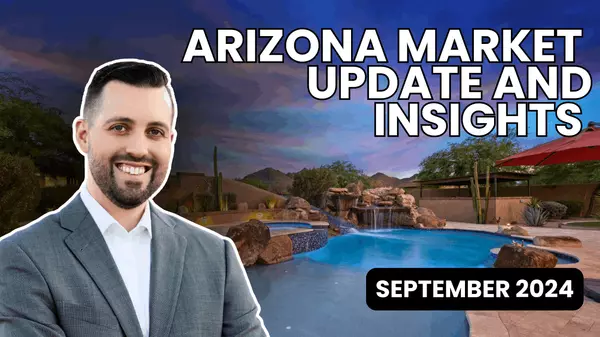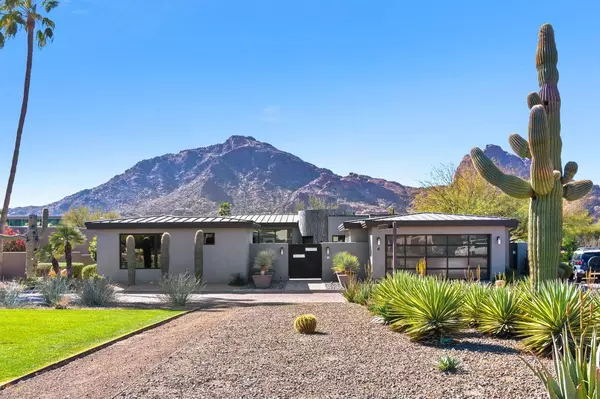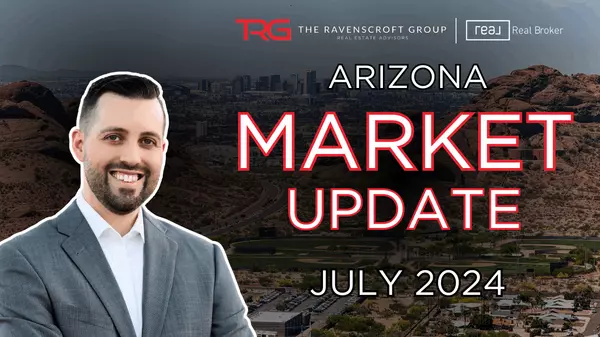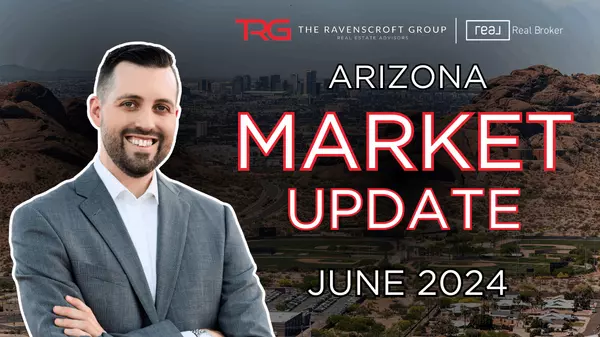October 2024 Arizona Real Estate Market Update: Key Insights, Buyer Opportunities, and 2025 Planning
Welcome to this month’s Arizona market update! For those receiving this for the first time, welcome. October has been a busy month, with many new clients and increasing interest from those exploring the Arizona market. Whether you’re a new real estate partner from across the country, a Veteran, referred by your CPA or financial advisor, or recently connected due to a job change, referral, or one of the companies relocating here in 2025, I'm here to provide insights to help guide your real estate journey.
Each month, I personally craft these updates—no automation, no outsourcing. My goal is to bring you valuable information and actionable knowledge to help you make well-informed decisions.
Arizona Market Update and Insights for October 2024
Market Sentiment: Buyer Hesitation, Seller Caution
Buyers are showing less motivation, and sellers are losing some confidence, leading to more frequent price cuts. Homes listed at lower or bargain prices are selling faster than those at full market value.
For the past five months, the market has seen month-to-month fluctuations, yet the annual averages remain relatively steady, hinting at a more stable long-term outlook than monthly shifts might imply.
Multi-Family Permits Drop, Interest Shifts to Single-Family Homes
In the third quarter of 2024, multi-family permits slowed significantly with only 3,142 units approved in Maricopa and Pinal counties—a 43% drop from last year. Investor enthusiasm for multi-family projects, strong from 2021 to 2023, has cooled, shifting back toward single-family homes, where demand remains steady.
Mortgage Rates on the Rise
Adding to the current climate, mortgage rates have edged higher. The average 30-year fixed rate now sits near 7%, up from 6.68% just last week—marking the highest level since late July.
Market Activity by City
Only four major cities showed an increase in their Market Index this past month. Phoenix, which makes up about 25% of all transactions in the area, held steady, while Paradise Valley saw the steepest drop, losing 30% over the month. On the positive side, Tempe and Cave Creek posted gains of over 7%, with Phoenix and Peoria also seeing positive movement. Most declines, aside from Paradise Valley, were concentrated in the Southwest—specifically Avondale, Goodyear, and Buckeye, areas with significant new construction.
A Rare Window of Opportunity for Buyers
For the first time this year, homes under contract have surpassed last year's numbers! September saw stability in mortgage rates around 6.1%-6.2% for conventional loans and 5.6%-5.7% for FHA loans, sparking a 12% increase in weekly accepted contracts. This suggests that rates below 6.5% are the tipping point for boosting buyer demand.
Contrary to some beliefs, this rate dip wasn’t due to the Federal Reserve’s 0.5-point cut in September, as mortgage rates had already adjusted ahead of time. This stability gave buyers confidence to make moves, offering a brief relief to the industry.
Currently, Greater Phoenix is a prime market for buyers. With active listings up and weekly contracts down, buyers enjoy a broad selection with less competition. In the past decade, Phoenix has only seen such buyer-friendly conditions twice—once in 2022 for nine weeks and in 2014 for five weeks. If you’re looking to buy, now is the time to take advantage of this unique window.
How Sellers Can Stay Competitive
While rates held in the low-6% range for a month, they’ve recently jumped back to nearly 7%. This increase, fueled by strong employment numbers, suggests a Federal Reserve rate cut may not be in the near future.
For now, it’s a buyer-friendly market, making it essential for sellers to be competitive. Serious sellers should ensure their property is in top condition to appeal to today’s buyers, who aren’t easily won over by price drops or allowances alone. Small, impactful upgrades—like fresh carpet, clean grout, or a bright coat of paint—can make a big difference in appealing to buyers who may lack the time or funds for home projects.
Homes priced between $275K and $500K may need to offer buyer incentives and expect longer marketing times during the holiday season. Many recent sales in this range included $8K-$10K in closing cost assistance from sellers, which can help offset mortgage rates for buyers. Sellers who purchased within the last two to three years may find it challenging to compete due to flat appreciation, but those with longer ownership periods have more flexibility.
Remember, today’s market competition isn’t just your neighbors—it's also new construction. Many builders are offering creative incentives like price flexibility and rate buy-downs, with some offering fixed rates as low as 3% for 30 years. One of my clients recently took advantage of this opportunity, highlighting the flexibility available in new builds.
Why ‘Average Days on Market’ Isn’t the Full Story
“Average days on market” is a common metric, but it doesn’t tell the full story. A more useful measure is the listing success rate, which currently sits at 71%—slightly above the long-term average but below last year’s 75%. Here’s a breakdown by price:
Under $200K: Success rate of 56%, often reflecting property-specific challenges
$250K-$400K: High success rate around 79%
Over $2M: Lower success rate at 50.6%
Success rates vary by area, so broad market data often provides a more reliable perspective.
Planning Ahead for 2025
As the market shifts, planning for the future becomes more important. Until the end of the year, I’m offering 2025 planning sessions, including a detailed cost comparison analysis. For instance, I recently helped a client evaluate a move from Oregon to Phoenix, breaking down costs like housing, utilities, and taxes. We found that Phoenix offered a 15% lower cost of living, translating to an estimated annual savings of $32,000—allowing them to boost retirement savings and even consider an investment property.
Final Thoughts
In today’s market, every shift creates new opportunities. Buyers have a slight advantage, while sellers need to focus on quality and strategic incentives to stay competitive. If you’re interested in exploring how a move could impact your finances or want to look at other markets, let’s connect to set you up for success in 2025!
Arizona Real Estate Market Update for September 2024: Trends, Insights, and Opportunities
Every month, I take the time to personally craft this update to bring you real, actionable insights. This is not just another generic newsletter filled with automation or outsourced content—it’s my way of keeping you informed and empowered with knowledge you can use. Let’s dive into what’s happening in Arizona's housing market for September 2024.
Housing Market Trends in Arizona – September 2024
We’re starting to see subtle yet significant signs of improvement in Arizona's housing market, primarily driven by lower mortgage rates. Listings under contract are up 2.5% from last year, a crucial change, considering the last year-over-year increase happened in January.
However, active listings are rising too, meaning many new buyers are also sellers, and the move-up market is where most activity occurs. While this is great news for those upgrading, the overall Arizona market index is still trending downward. So, while we’re seeing some progress, the housing market remains far from a full recovery.
How Falling Mortgage Rates Are Impacting Arizona's Market
When the Federal Reserve cut its benchmark rate by 50 basis points, many anticipated mortgage rates would follow suit. But instead, mortgage rates edged up slightly, mainly because they are influenced by the 10-year Treasury bond yield, not the Fed's rate.
This highlights how unpredictable mortgage rates can be. People often try to time the market, hoping for lower rates or political changes to impact their decisions. However, the reality is that the housing market is less affected by politics than many think. For example, while the rate cut made Arizona real estate more affordable for foreign buyers by weakening the dollar, this shift had more to do with economic fundamentals.
Buyers Are Gaining Leverage in Arizona
As buyers gain more leverage in negotiations—especially in lower and middle price ranges—the real estate market is slowly shifting. Though still moderate, buyers are starting to have the upper hand, especially in cities like Fountain Hills, which posted a 10% market index increase, and Paradise Valley, which surged ahead with an impressive 25% gain.
Other cities showing slight improvements include:
Buckeye
Scottsdale
Cave Creek
Surprise
Glendale
However, cities like Phoenix and Mesa have seen market index declines, along with Avondale, Chandler, and Peoria.
Struggles in the Outer Edges of the Arizona Market
The outer edges of the Arizona market are seeing the most significant struggles. Cities like Coolidge, Arizona City, Tonopah, Eloy, and Florence are among the weakest performers. On the flip side, 55+ communities are seeing mixed results, with Sun City and Sun City West showing modest gains of 1.7%, while Sun Lakes held steady with a 4.6% rise.
Opportunities for Savvy Home Buyers in Arizona
Did you know that recessions often signal a housing market rebound? After more than two years of sluggish sales, both buyers and sellers are beginning to re-enter the market.
Historically, home prices have remained stable, and mortgage rates tend to decline during recessions. According to Arizona’s employment report, private sector earnings rose by 7.3% year-over-year, outpacing both inflation and home price growth. This presents an excellent opportunity for buyers as higher incomes, lower rates, and stable home prices create a favorable environment.
Buyers should take advantage of increased listings in cities like Phoenix, Scottsdale, and Peoria. With less competition and more homes available, the next few months could provide the perfect window to buy.
Why Now is the Time to List: Sellers Seize Opportunities
September and October are the last big months for home sales before the holiday season kicks in. Homes currently stay on the market for around 33 days before securing an offer. So, if you’re planning to sell, now is the time to list and ensure your home stands out from the competition.
For homes under $2 million, lower mortgage rates are expected to drive demand. However, the luxury real estate market—especially homes priced over $2M—may see slower sales as 55% of these transactions are cash deals, unaffected by mortgage rates. Nevertheless, September luxury listings are performing better than in previous years.
Debunking the Myth of Political Impact on Arizona Real Estate
As we approach the November elections, it’s natural for people to wonder if political outcomes will affect the housing market. However, the truth is that presidential elections have little impact on home sales.
Looking at historical data, we can see that home sales in election years tend to follow typical market patterns:
2004 and 2020 saw stronger sales than non-election years.
2012 and 2016 aligned with normal trends.
2000 and 2008 had weaker sales, though both coincided with recessions.
The reality is that home sales are driven more by life events—like family changes, job relocations, and estate matters—than by political decisions.
FAQ: Frequently Asked Questions about the Arizona Housing Market
Q: How is the Arizona housing market performing in September 2024?A: The Arizona housing market is showing signs of improvement, with a 2.5% increase in listings under contract compared to last year. However, active listings are also rising, making this a buyer-friendly market.
Q: What are the best cities to buy a home in Arizona right now?A: Cities like Phoenix, Mesa, Avondale, Chandler, and Peoria are seeing market declines, making them ideal for buyers looking for better negotiating power and opportunities. While Fountain Hills and Paradise Valley are seeing positive market gains, which are more favorable for sellers, buyers may find good options in cities with downward trends in the market index.
Final Thoughts: Stay Focused on the Bigger Picture
As always, stay focused on the long-term picture. Real estate is a long-term game, and trying to time the market based on fleeting trends or political events often leads to missed opportunities. Focus on sound strategies and the fundamentals that drive long-term success in real estate.
If you’re looking to buy or sell in Arizona, don’t hesitate to reach out. The market may fluctuate, but a solid plan is always key to building and preserving wealth through real estate.
Rebounding Trends: Single-Family Building Permits Surge in Maricopa and Pinal Counties
Rebound in Single-Family Building Permits in Maricopa and Pinal Counties
In 2024, Maricopa and Pinal counties have witnessed a significant rebound in single-family building permits. So far, 18,498 permits have been issued, marking a 40% increase compared to the same period last year. Although this growth is promising, it still falls short of the peak levels seen in 2021 and 2022, where 21,796 and 19,748 permits were issued, respectively.
For more details on how building permits have fluctuated over the past years, check out our previous market update.
New Home Market vs. Resale Market: What You Need to Know
One of the most intriguing trends this year is the performance gap between the new home market and the resale market. As of June 2024, year-to-date resale closings have reached 45,937, reflecting a 4% decline compared to the same period last year. This divergence highlights the unique dynamics at play, with the new home market showing resilience despite a generally weaker resale market.
If you're interested in the latest trends in the resale market, visit our resale market trends page.
Homebuilders' Optimism and Stock Market Trends
Homebuilders are increasingly optimistic about future market conditions, spurred by the Federal Reserve's stance on potential interest rate reductions. This positive outlook has been mirrored in the stock market, with several publicly traded homebuilders hitting record-high prices recently. This trend underscores the confidence within the industry, even as the broader market experiences challenges.
For more information on how interest rates are impacting the market, let's schedule a 1 on 1 to discuss.
Surge in Building Permits Across Arizona
Maricopa County has seen a 39% rise in building permits, while Pinal County has experienced a 43% increase. Across Arizona's other counties, permits have risen by nearly 38%. San Tan Valley continues to face challenges with incorporation, resulting in many new homes being developed under county jurisdiction. However, there is growing momentum for incorporation, with a vote planned later this year.
Florence, another rapidly growing area, has now surpassed Gilbert in permit issuance and is closing in on Scottsdale’s numbers. This shift highlights the changing dynamics in Arizona’s housing market, with new areas emerging as key development hubs.
Positive Indicators for Sellers in August 2024
The market is starting to show more positive signs from a seller's perspective. As of August 2024, nine cities have seen an increase in their Market Index, up from eight cities last week. Conversely, eight cities are experiencing a decline, indicating a mixed but improving market landscape for sellers.
Notable gains have been recorded in Cave Creek, Paradise Valley, Buckeye, and Fountain Hills. Cities like Scottsdale, Gilbert, Maricopa, Goodyear, and Peoria have also posted increases this past month. However, significant declines have been observed in the Southeast Valley, particularly in Tempe, Chandler, and Mesa, as well as in Avondale.
Currently, nine out of the 17 cities analyzed are in a seller’s market, with a market index above 110. Three cities are balanced, and the remaining five are classified as buyer’s markets.
For a more detailed analysis of the market conditions, check out our monthly market index.
Impact of Interest Rate Changes on Arizona’s Real Estate Market
On August 5th, the housing market experienced a sudden shift, with mortgage rates effectively going on sale. Average mortgage rates dropped sharply to 6.3% before stabilizing at 6.5%, a significant improvement from April’s 7.5%. This decrease has led to a 10% to 11% reduction in principal and interest payments for buyers across all loan amounts.
For instance, loans between $300K and $400K have seen monthly payment reductions of $200 to $270, while loans between $450K and $550K have experienced savings of $300 to $370 per month.
This decline in rates sparked immediate market reactions. Refinance applications jumped 16% week-over-week, as many homeowners with rates between 7% and 8% from the past year reconsidered their options. Purchase applications also saw a modest rise of 1%, reflecting the typical buyer approach of waiting to see if rates will drop further.
For more on how to navigate the current mortgage landscape and to run projection based on your specific situation, please contact me.
Sellers Offering More Concessions
In August, a record 55% of sellers offered concessions, such as covering buyers' closing costs, with half contributing $9,800 or more. Despite lower rates, tools like the 2/1 buy-down remain popular, providing a seller-funded temporary rate reduction that covers 10%-20% of the buyer’s payments for the first two years.
To illustrate the impact: A rate drop from 7.5% in April to 6.5% in August on a $400,000 loan lowers the monthly principal and interest payment from $2,797 to $2,528, saving buyers $269 per month. If paired with a 2/1 buy-down, the first-year rate could drop to 4.5%, bringing the monthly payment down to $2,027—a total savings of $770 per month.
Explore our sellers’ guide for more strategies on how to maximize your home sale in the current market.
Strategies for Sellers in the Current Market
As mortgage rates continue to improve gradually, sellers need to remain patient when listing their homes. Unlike the stock market, where reactions to Federal Reserve announcements are immediate, homebuyers move at a slower pace—they still need to apply, submit paperwork, and plan their moves. Currently, half of the sellers accepting contracts this month were on the market for 37 days or more.
Greater Phoenix remains a balanced market, though buyers have an advantage in several cities. Prices have been mostly stagnant, with only a 1.9% increase compared to last year. While it may be tempting to push for the highest price, this approach can lead to extended market time and more price reductions, which are up 67% from last year.
Setting realistic expectations is key to a positive selling experience. In a balanced market, sellers can't anticipate the high returns seen in a seller’s market. Listings demand careful strategy and effort, even when the property is in great condition. As the real estate industry faces increased scrutiny and changes, the expertise of skilled professionals is more crucial than ever.
In Summary: Opportunities Amid Market Shifts
Sellers have enjoyed a strong market for quite some time, so today’s balanced conditions might feel unfamiliar or even unsettling. While some areas like Buckeye, Maricopa, Queen Creek, Surprise, and Goodyear are showing signs of a buyer's market, we’re still not in a buyer's market overall. The recent dip in mortgage interest rates earlier this month has already brought some improvement.
Looking ahead, I expect price recovery between now and September, with current pending listings showing 99.2% normal transactions, 0.2% REOs, and 0.7% pre-foreclosures and short sales. Foreclosure activity remains low, indicating that the recent softness in sales prices isn’t being driven by distressed properties.
Although the past three months have seen weaker-than-usual sales prices following a strong April, I believe this period of decline has likely ended, and prices are poised to rebound. If recovery doesn’t occur within the next month, I anticipate a turnaround by mid-October. The high-end market has been particularly quiet during the hottest months, but its resurgence will likely boost overall sales price averages in the coming months.
While market shifts can be challenging, they also present opportunities. By staying informed and adaptable, we can navigate these changes successfully and make the most of the current landscape. The market remains full of potential, and positive trends are just around the corner.
FAQ: August 2024 Real Estate Market
Q: What are the current mortgage rates in Arizona?A: As of August 2024, average mortgage rates have dropped to 6.5%, a significant improvement from April's 7.5%. This has led to a reduction in monthly payments for buyers across all loan amounts.
Q: Is it a good time to buy a home in Maricopa or Pinal County?A: With recent drops in mortgage rates and ongoing new home developments, now may be a favorable time to buy, especially in areas like Florence and San Tan Valley, which are seeing significant growth.
Q: What should sellers keep in mind in the current market?A: Sellers should set realistic expectations and be patient, as the market is currently balanced. Offering concessions and pricing strategically can help achieve a successful sale.
Q: How are new home building permits trending in 2024?A: Building permits in Maricopa and Pinal counties have increased by 40% compared to last year, signaling a rebound in new home construction.
If you have any questions or would like to discuss how these market trends could impact your buying or selling decisions, I'd love to chat. Feel free to schedule a time with me using the link below.
Arizona Real Estate Market Update: July 2024 Insights and Trends
Welcome to the latest update on the Arizona real estate market for July 2024. Whether you're looking to buy, sell, or invest, staying informed is key to making savvy decisions. Let’s dive into the current state of the Greater Phoenix residential market and what the rest of the year might hold.
Market Overview: First Half of 2024
The first half of 2024 has seen a quieter than usual market in Greater Phoenix. While there's no cause for alarm, closing volumes are notably below average, and buyer enthusiasm has cooled. Supply levels are higher compared to last year but still fall short of the long-term average—and they’re beginning to dip. This balance between supply and demand has created a stable market overall, though different areas and price ranges tell varying stories.
Supply and Demand Dynamics
Supply: Supply is up compared to last year but remains below the long-term norm. There’s more supply on the outer edges of the Valley, while central areas see stronger demand.
Demand: Buyer enthusiasm is softening, leading to lower transaction volumes. However, a slight downward trend in mortgage rates could gradually reignite interest.
Mortgage Rates and Market Balance
Mortgage rates continue to play a pivotal role in shaping the market. While rates have started to inch downward, the market remains sluggish. Despite the higher supply levels compared to last year, the overall balance is holding steady. A drastic market correction seems unlikely, given the low levels of mortgage delinquency, motivated—but not desperate—sellers, and a manageable supply-to-demand ratio.
Distress Levels and Lending Risk
Distress Levels: Foreclosure rates remain impressively low, signaling a healthy market.
Lending Risk: The average credit score of homebuyers is higher than ever, minimizing the risk of lending issues similar to those seen before the 2007 housing crash.
Current Market Status: July 2024
The market remains balanced, but signs of a buyer's market are emerging in certain areas. Over the past month, cities like Scottsdale, Avondale, Queen Creek, and Maricopa have seen their market indexes rise. In contrast, 13 cities have shown declines, indicating growing challenges for sellers.
Cities Shifting in Favor of Buyers
Several cities are now leaning toward buyers, including Tempe, Gilbert, Glendale, Chandler, Fountain Hills, and Paradise Valley.
Buyer Insights: Opportunities in 2024
The latter half of 2024 presents a more favorable environment for buyers, especially with mortgage rates showing signs of stability. Last year, rates soared from 7% to 8% between July and October, pushing many potential buyers out of the market. This year, however, analysts predict a steadier rate environment, which could ease affordability concerns.
Factors Influencing Mortgage Rates:
Federal Reserve Decisions: The Federal Reserve's actions on the Federal Funds Rate, with a focus on inflation and the labor market, remain crucial.
Inflation Rates: Inflation recently dipped to 3.0%, better than expected, prompting a decrease in mortgage rates to 6.82%. If this trend continues through the summer, we may not need price drops to see homes become more affordable.
Market Conditions for Buyers:
Contract Times: Homes are staying on the market longer, with half of the homes under contract last month spending over a month listed, compared to just 21 days a year ago.
Price Reductions: Price reductions are up 88% year-over-year.
Seller-Paid Incentives: A notable 51% of sales included seller-paid incentives, with the median concession reaching $10,000 last month, a 5% increase from May.
New Construction: A Buyer’s Best Bet
New construction continues to offer the most attractive incentives and lower payments for buyers. Although there are still good deals in the resale market, new homes are the best option for those looking for favorable terms. This trend is expected to continue, especially with builders pushing to meet their fiscal year-end on September 30, 2024.
Seller Insights: Market Challenges and Strategies
The Greater Phoenix market has remained balanced for the past few months, but buyers are increasingly gaining confidence in negotiations. Cities like Peoria and Paradise Valley have shifted from a seller's market to a balanced one, while areas like Surprise, Goodyear, and Cave Creek are now favoring buyers. In fact, 14 of the 17 largest cities in the Valley are trending toward buyers.
New Construction Impact:
New construction is significantly influencing the market, particularly in West Valley and Pinal County, where nine cities have shifted to buyer's markets. With single-family permits up 56% year-to-date, builders are optimistic about the region’s growth. This confidence is not reflected elsewhere in the country, making Greater Phoenix a unique market. As new inventory enters the market, builders face little competition from resale listings, with new construction comprising 27% of all single-family home sales in the first half of 2024.
Sales Prices Holding Steady:
Median Sales Price: Up 1.9% from last year.
Average Sales Price per Square Foot: Increased by 2.6% annually as of June.
Preparing for a Balanced Market:
Sellers need to adjust their strategies in this balanced market. Proper home preparation, realistic pricing, and readiness to negotiate buyer concessions are crucial. Alternatively, rather than selling in a less-than-ideal market, consider renting out your property. This strategy allows you to generate income or cover your mortgage while waiting for a more favorable market to sell.
Conclusion: Market Outlook and Advice
The Arizona real estate market is as close to balanced as it’s likely to get this year. Sellers are facing tougher competition and fewer buyers, making it more challenging than in the past decade. For buyers and investors active during the summer, opportunities exist, but you’ll need to be strategic. With last month’s sales down 15% compared to the previous year, low volumes are expected to persist through September, with seasonal price dips. However, the market is likely to rebound in October—potentially faster if interest rates drop, though that’s not a certainty.
Thanks for reading this market update. If you have questions or want to discuss your real estate needs, feel free to reach out. Stay informed and make smart decisions in the market!
Arizona Real Estate Market Update: June 2024 Insights for Buyers, Sellers, and Investors
Welcome to the Arizona Market Update for June 2024! Whether you're a buyer, seller, or investor, staying informed about the real estate market is crucial. Let’s dive into the latest trends and insights that matter to you.
Current Market Conditions
The real estate market is witnessing significant changes this month:
Increased Inventory: The number of homes for sale has grown faster than last month, offering buyers 54% more choices compared to last year.
High Mortgage Rates: With 30-year mortgage rates still over 7%, buyers are finding it tougher to make purchases. Sellers face increased competition, and agents are working diligently to close deals.
Price Trends
Average Price per Square Foot: Up by only 3.5% over the last year.
Median Sale Price: Increased by just under 6%, largely unaffected by the luxury home market.
Price Forecast: Expect prices to remain flat or decrease over the next three months after a strong rise from January to May.
Seasonal Trends
Summer Slowdown: From June to September, luxury home buyers are fewer, preferring cooler locations over Phoenix’s summer heat.
Investor Activity: Investors are active during the summer, capitalizing on good deals and healthy profit margins on fix-and-flip houses, which lowers the average price per square foot during these months.
New Construction vs. Resale Market
New Home Market: Healthier than the resale market, adding extra competition for sellers.
Incentives: New construction incentives have been significantly higher, with discounts of 8-9% off the purchase price, plus extras like closing cost credits, appliances, and blinds.
Market Index and Area Performance
Current Market Index: At 103 and trending down. Sellers are getting worried, and buyers aren’t too excited.
Market Conditions: Out of 17 cities, 11 are still seller's markets (though mostly weak ones), 1 city (Goodyear) is balanced, and 5 cities are buyer’s markets.
Key Areas: Gilbert, Peoria, Goodyear, Paradise Valley, Mesa, and Glendale are moving in favor of buyers, with Gilbert's market deteriorating the fastest. Maricopa is moving in favor of sellers.
Federal Reserve and Mortgage Rates
Interest Rates: The Federal Reserve kept the Federal Funds Rate steady for 12 months straight.
Inflation and Mortgage Rates: The Consumer Price Index showed a drop in the annual inflation rate to 3.3%, causing conventional mortgage rates to decrease from 7.16% to 6.98% in one day.
Future Outlook: A potential rate cut later this year, possibly in September, could further lower mortgage rates and improve the market.
Buyer and Seller Strategies
Homes Under $500,000: Buyers focus on monthly payments over final sale prices. About 55% of sales in this range include seller incentives, with a median incentive of around $14,600, making the true sale price about 4% off the list price.
Homes Over $1 Million: Buyers prefer direct price negotiations, resulting in an average price reduction of $51,000 this June, closing at 94.9% of the list price.
Seller Tips
Navigating the Market: Sellers, especially in areas with new construction, need to navigate carefully. Homes that need repairs or maintenance are struggling the most. Even well-maintained homes may face longer market times and potential price reductions. Managing expectations and staying patient are key to successful sales.
Rental Market Opportunity
Explore Rental Options: Renting out your home can be a profitable option. By renting, you can keep your low interest rate and cost basis while turning your property into an income-generating asset. Enjoy long-term appreciation, leverage, tax benefits, and a steady income stream. Contact me to review your potential rental income and estimated tax benefits.
Conclusion
As we move forward, expect stability in pricing with a slight tendency towards weakness. While we're not in a situation like 2007, buyer enthusiasm for resale homes remains low. However, if the 30-year fixed mortgage rate drops below 7%, the market could improve. Let’s stay positive and keep a close watch on these trends as we navigate through the rest of the year.
Schedule a Chat
If you want to discuss the current market and what it means for you, please schedule a time for us to chat below.
Navigating Arizona's Shifting Real Estate Market in 2024: Key Insights for Buyers and Sellers
The Arizona real estate market is experiencing a period of transition in 2024. Fluctuating mortgage rates, evolving buyer preferences, and a shifting supply-demand dynamic are impacting both buyers and sellers. Understanding these changes is crucial for navigating this evolving landscape and making informed decisions.
Mortgage Rates and Demand
Since early May, mortgage rates have hovered between 7% and 7.25%, a slight improvement from the 7.25% to 7.5% range seen earlier in the year. While these rates are still higher than the historically low levels of 2020 and 2021, they have led to a significant decrease in demand compared to the previous year. Listings are down 7% overall and nearly 10% lower than May 2023.
Rising Supply and Market Trends
The supply of available homes is slowly increasing, which could potentially favor buyers in the near future. This trend is particularly evident in resale markets, where competition from new construction is also playing a role.
One notable trend is the growing preference for move-in-ready homes over fixer-uppers. This shift in buyer behavior benefits fix-and-flip investors, offering opportunities with less competition from traditional buyers. However, rising costs due to inflation can eat into those profits, requiring careful consideration of the overall investment strategy.
Market Index and City Highlights
The Phoenix housing market has shown surprising resilience despite the rate fluctuations. The overall Market Index, which uses a scale of 1-100 to indicate market conditions (buyer's market below 90, balanced market 90-100, seller's market above 100), remains just above the balanced zone.
While five cities saw an increase in their market index this past month, twelve have declined. Paradise Valley, Fountain Hills, and Goodyear are leaning towards a seller's market, while Tempe, Glendale, Gilbert, and Maricopa are shifting towards a buyer's market. Interestingly, Chandler has lost some steam, while Fountain Hills has seen a significant increase (up 20%), potentially signaling a new leader in the coming months.
Current Market Status
Currently, 11 out of 17 major cities in Arizona are in a seller's market, although most are soft/weak sellers markets nearing balance. Goodyear is the only balanced market, and five cities are leaning towards a buyer's market. Areas closer to the center of the valley still have tight supply, favoring sellers. However, resale markets like Maricopa, Buckeye, and San Tan Valley are experiencing strong competition from new homes, creating a buyer-friendly environment.
Advice for Buyers
If you're a buyer in the Arizona market, there are several reasons to be optimistic:
Less Competition: High mortgage rates have kept many buyers away, leading to fewer bidding wars and a more relaxed buying process.
More Homes to Choose From: The increase in available listings provides a wider range of options and greater flexibility for buyers.
Seller Flexibility: Sellers are often more willing to negotiate and consider offers in this market.
Longer Listing Times: Homes are typically staying on the market for longer, giving buyers more time to find the right property.
Increased Price Cuts: Sellers are increasingly willing to offer concessions and price reductions to attract buyers.
New construction also presents a unique opportunity for buyers, as many builders are offering attractive incentives like low interest rates and closing cost assistance. These deals can significantly improve affordability and make homeownership more accessible.
Advice for Sellers
The market is shifting towards a balanced or buyer's market in many areas. Gone are the days of selling homes "as-is" with numerous issues. Buyers prioritize move-in-ready homes in good condition, and sellers need to adapt their strategies accordingly.
Here are some key steps for sellers to consider:
Prepare Your Home: Clean, update, and fix any problems to make your property more appealing to buyers.
Price Strategically: Research the market and set a realistic price based on current conditions and comparable listings.
Market Effectively: Utilize professional photography, staging, and marketing strategies to showcase your home's best features.
Be Flexible: Be open to negotiations and consider offering concessions to attract buyers.
Alternatively, renting out your property can be a viable option. This allows you to keep your low interest rate and cost basis, while generating income and benefiting from long-term appreciation, leverage, and tax advantages.
In Summary
The Arizona real estate market is undergoing a period of change, and understanding the current dynamics is crucial for both buyers and sellers.
Buyers: Take advantage of the current market conditions to find your dream home with less competition, more options, and greater flexibility.
Sellers: Adapt your strategy to the shifting market, prepare your home for sale, and be open to negotiations to attract buyers.
Remember, real estate is a long-term investment. By staying informed and making informed decisions, you can navigate the changing landscape and achieve your goals in the Arizona market.
Additional Resources
Schedule time below for a personalized consultation and to discuss your specific situation.

Eric Ravenscroft, CRS
Phone:+1(805) 815-5695
Leave a Message
REQUEST A TOPIC TO BE PUBLISHED






